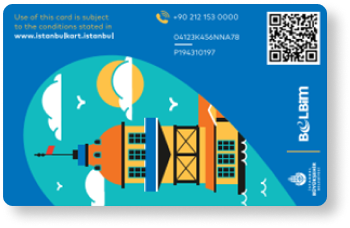
Cappadocia's Christian Heritage: Exploring the Ancient Churches and Monasteries
Cappadocia is a region in central Turkey that is rich in history, culture, and natural beauty. One of the most fascinating aspects of the region is its Christian heritage, which dates back to the early days of the faith. In this article, we'll explore the many ancient churches and monasteries in the region, and discover the stunning frescoes and mosaics that adorn their walls.
But first, let’s look at the best way to discover this amazing region! Cappadocia Travel Pass® is a unique and convenient way to explore the stunning region of Cappadocia. With this pass, visitors can enjoy exclusive access to a range of attractions, including museums, historical sites, and cultural events. Whether you're interested in exploring the region's rich history and heritage or simply soaking up its natural beauty, Cappadocia Travel Pass® makes it easy and affordable to do so. Plus, with the ability to skip the line at popular attractions and enjoy discounts on dining and shopping, this pass is the perfect way to make the most of your time in Cappadocia. Click here to see a complete list of the attractions included!
The History of Christianity in Cappadocia
Cappadocia has a long and complex history, dating back to the Hittite Empire in the second millennium BCE. However, it was in the first century CE that Christianity began to take root in the region. According to tradition, the apostle Peter preached in Cappadocia, and the apostle Paul may have also visited the region. In the early centuries of the Christian era, Cappadocia became an important center of monasticism, with many hermits and monks seeking solitude in the region's rugged landscape. The history of Christianity in Cappadocia is a fascinating and complex one that spans centuries and encompasses a wide variety of religious beliefs and practices. In this article, we will explore the major milestones of this history, from the earliest days of Christianity to the present.
The Early Days of Christianity in Cappadocia
Christianity arrived in Cappadocia in the first century AD, soon after the death of Jesus Christ. According to tradition, two of the apostles, St. Paul and St. Peter, visited the region and preached the gospel to the local people. These early missionaries were met with resistance from the local Roman authorities, who viewed Christianity as a threat to their power.
Despite this opposition, Christianity continued to spread throughout the region, and by the third century AD, Cappadocia had become a stronghold of the Christian faith. Many of the early Christian communities in Cappadocia were established in remote areas, such as the valleys and caves of the region, where they could practice their faith without fear of persecution.
The Golden Age of Christianity in Cappadocia
The fourth century AD is considered the golden age of Christianity in Cappadocia. During this time, the region was ruled by the Cappadocian Fathers, a group of influential theologians and leaders who played a major role in the development of Christian doctrine and theology.
One of the most famous Cappadocian Fathers was St. Basil the Great, who founded a monastery in the region and is known for his contributions to Christian theology and philosophy. Other notable figures from this period include St. Gregory of Nyssa and St. Gregory Nazianzus, both of whom were bishops and theologians who played a major role in shaping the early Christian church.
The Legacy of Cappadocian Christianity
The legacy of Cappadocian Christianity is still evident in the region today, in the form of the many churches, monasteries, and other religious sites that dot the landscape. These sites are a testament to the enduring impact of Christianity on the culture and history of Cappadocia, and they offer visitors a chance to explore the rich history and heritage of this fascinating region.
In recent years, efforts have been made to preserve and protect these ancient sites, and many of them have been designated as protected areas by the Turkish government. The churches and monasteries of Cappadocia continue to attract visitors from around the world, who come to marvel at the beautiful frescoes, mosaics, and other works of art that adorn their walls.
In conclusion, the history of Christianity in Cappadocia is a rich and complex one that offers valuable insights into the development of the Christian faith over the centuries. From the earliest days of Christianity to the present, Cappadocia has played a major role in shaping the religious and cultural history of Turkey, and its churches and monasteries are a testament to the enduring legacy of this important chapter in Christian history.
The Ancient Churches of Cappadocia
One of the most striking features of Cappadocia's Christian heritage is its many ancient churches, carved into the soft volcanic rock of the region. These churches are notable for their unique architecture, with many featuring intricate domes, vaulted ceilings, and complex apses. However, it is the frescoes and mosaics that adorn the walls of these churches that are truly breathtaking. These artworks are not only beautiful but also provide important insights into the religious beliefs and practices of the people who created them.
Some of the most famous churches in Cappadocia include:
The Goreme Open Air Museum: This UNESCO World Heritage Site contains several churches, chapels, and monasteries, dating from the 10th to the 12th centuries. The frescoes in these churches depict scenes from the Bible and the lives of the saints and are notable for their vivid colors and intricate details. Goreme Open Air Museum is a great place to visit and entrance is FREE with Cappadocia Travel Pass®.
The Dark Church: This church, located in Goreme, is famous for its dark interior, which has helped to preserve its stunning frescoes. The frescoes in the Dark Church depict scenes from the New Testament, such as the Nativity and the Crucifixion, as well as scenes from the lives of the saints.
The Church of St. John the Baptist: This church, located in the village of Cavusin, is notable for its unique architecture, which includes a rock-cut bell tower. The frescoes in the church depict scenes from the life of John the Baptist, as well as images of the Virgin Mary and Christ.
The Monasteries of Cappadocia
In addition to the churches, Cappadocia is also home to several ancient monasteries, which played an important role in the region's Christian history. These monasteries were often built in secluded locations, such as the tops of cliffs or the depths of valleys, in order to provide monks with the solitude and peace they sought. Many of these monasteries feature elaborate frescoes and mosaics, as well as unique architectural features such as rock-cut stairs and courtyards.
Some of the most famous monasteries in Cappadocia include:
The Monastery of St. Simeon: This monastery, located near the village of Soganli, is notable for its stunning frescoes, which depict scenes from the lives of the saints and the miracles of Christ. The monastery also features a rock-cut church and several rooms carved into the rock.
The Monastery of St. Nicholas: This monastery, located near the town of Avanos, is named after the popular saint who is known as the patron of sailors and children. The monastery features several rock-cut churches, as well as a well-preserved refectory and living quarters for the monks.
The Monastery of Gulludere: This monastery, located in the Ihlara Valley, is notable for its stunning frescoes, which depict scenes from the lives of the saints and the early days of Christianity. The monastery also features a rock-cut church, a refectory, and several living quarters.
Preserving Cappadocia's Christian Heritage
Cappadocia's Christian heritage is an important part of Turkey's cultural and religious history, and efforts are being made to preserve and protect the ancient churches and monasteries in the region. The Turkish government has designated many of these sites as protected areas, and UNESCO has recognized several of them as World Heritage Sites.
Visitors to Cappadocia can explore these ancient churches and monasteries, marveling at the beautiful frescoes and mosaics that adorn their walls. They can also learn about the rich history and culture of this fascinating region, and gain a deeper appreciation for the role that Christianity has played in shaping Turkey's past and present.
In conclusion, Cappadocia's Christian heritage is a fascinating topic that offers a glimpse into the ancient history of Christianity in Turkey. The region's many churches and monasteries are not only beautiful but also provide important insights into the religious beliefs and practices of the people who created them. Visitors to Cappadocia can explore these sites, and gain a deeper appreciation for the rich cultural heritage of this fascinating region.
Cappadocia Travel Pass® is not just a convenient way to explore the region – it's also a way to support the local community. By purchasing this pass, visitors are directly contributing to the preservation of Cappadocia's rich cultural heritage and supporting local businesses and artisans. In addition to providing access to a range of attractions, Cappadocia Travel Pass® also includes special discounts and offers from local partners like Tik Tik Women Co-Op Eatery. So not only will you have an unforgettable experience exploring this unique region, but you'll also be making a positive impact on the local community.
FAQ
What is Cappadocia's Christian heritage?
Cappadocia's Christian heritage refers to the numerous churches, monasteries, and other religious sites located throughout the region that have been carved into the soft volcanic rock. These sites are a testament to the enduring legacy of Christianity in the region, which dates back to the earliest days of the faith.
What makes Cappadocia's Christian heritage unique?
What makes Cappadocia's Christian heritage unique is the fact that many of the churches and monasteries are carved directly into the rock, giving them a distinctive and otherworldly appearance. Additionally, the region's Christian heritage is notable for its rich history and the important role it played in the development of the Christian faith.
What are some of the most important Christian sites in Cappadocia?
Some of the most important Christian sites in Cappadocia include the Goreme Open-Air Museum, the Uchisar Castle, the Monastery of St. Nicholas, and the Monastery of Gulludere. These sites feature beautiful frescoes and other works of art, as well as stunning examples of rock-cut architecture.
Why is Cappadocia's Christian heritage important?
Cappadocia's Christian heritage is important for a variety of reasons. For one, it offers valuable insights into the development of the Christian faith and the role it played in shaping the culture and history of the region. Additionally, the many churches and monasteries in the region are important examples of ancient rock-cut architecture and art, and they provide a fascinating glimpse into the lives and beliefs of the people who created them.
How can visitors learn more about Cappadocia's Christian heritage?
Visitors can learn more about Cappadocia's Christian heritage by visiting the many churches, monasteries, and other religious sites located throughout the region. They can also take guided tours, visit museums, and attend cultural events to gain a deeper understanding of the region's rich history and heritage.
How did Cappadocia's unique landscape influence the development of its Christian heritage?
The unique landscape of Cappadocia, with its soft volcanic rock formations, was instrumental in the development of its Christian heritage. The rock was easy to carve, allowing early Christian communities to create underground churches and monasteries that were hidden from view and offered protection from persecution. This, in turn, helped to foster a strong sense of community and solidarity among the region's Christian population.
What role did Cappadocia's Christian heritage play in the wider Christian world?
Cappadocia's Christian heritage played an important role in the wider Christian world, particularly in the development of Christian theology and spirituality. Many of the region's most important Christian figures, such as St. Basil the Great, St. Gregory of Nyssa, and St. Gregory Nazianzen, were instrumental in shaping the early Christian church and their writings and teachings continue to influence Christian thought to this day.
How have modern-day efforts to preserve Cappadocia's Christian heritage impacted the region?
Modern-day efforts to preserve Cappadocia's Christian heritage have had a significant impact on the region, both in terms of cultural preservation and tourism. By restoring and maintaining ancient churches and monasteries, the region has been able to attract visitors from all over the world who are interested in learning more about its rich history and heritage. Additionally, these preservation efforts have helped to protect these sites from the damaging effects of time and weather, ensuring that they will continue to be appreciated and studied for generations to come.
How have local communities in Cappadocia been involved in the preservation and promotion of the region's Christian heritage?
Local communities in Cappadocia have played a vital role in the preservation and promotion of the region's Christian heritage. Many have been involved in restoration projects and have worked to raise awareness of the importance of these sites to the wider world. Additionally, local cultural events, such as music and dance performances, have helped to bring attention to the region's rich history and have provided opportunities for visitors to experience Cappadocia's Christian heritage in a more interactive and engaging way.
What can we learn from Cappadocia's Christian heritage that can be applied to contemporary society?
There are many lessons that can be learned from Cappadocia's Christian heritage that can be applied to contemporary society. For one, the enduring legacy of Christianity in the region is a testament to the power of faith to inspire and unite people, even in the face of adversity. Additionally, the region's unique rock-cut architecture and art offer a glimpse into the creativity and ingenuity of early Christian communities and can inspire us to seek out new and innovative ways of expressing ourselves and our beliefs.




 Travel around Istanbul freely
with Public Transportation Card
Travel around Istanbul freely
with Public Transportation Card
Buy your unlimited Istanbul Public Transportation Card now. We deliver it your hotel before you arrive.





Latest Posts

Why Should You Visit Cappadocia? Updated for 2023
Have you ever wondered where all those lovely photographs of a valley seen from a hot air balloon originate from? Cappadocia, tucked right in the heart of Turkey's Anatolia region, is one of the country's tourism centers, despite its tiny size. And w...

Cappadocia: Hot Air Balloon Flight Guide 2023
Have you ever wondered what it feels like to fly? To float among the birds in the sky and enjoy a bird’s eye view of the gorgeous surroundings around you? Hot air balloons in Cappadocia, Turkey provide just that and more – all the while delivering an...

Underground Cities of Cappadocia
The ancient underground cities of Cappadocia may strike the interest of even the most claustrophobic person! Every year tens of thousands of tourists around the world visit Cappadocia to discover these mysterious caves and learn about their history. ...

How far is Cappadocia from Istanbul?
The distance between Cappadocia and Istanbul is around 730 km (454 miles). This may seem like a lot but think about all the adventures you will experience once you arrive! Furthermore, there are many ways to get there and you will surely find one tha...

Top Things to Do in Cappadocia
Wondering about things to do in Cappadocia? Trying to arrange your trip but there are many question marks. Cappadocia Travel Pass® provides over 25 attractions, with just one pass – so book yours NOW! Here is a list of the main must-do activities but...

The Top 20 Amazing Cave Hotels in Cappadocia
Looking for a unique, one-of-a-kind place to stay in Cappadocia? Why not try a cave hotel? There are plenty of incredible cave hotels in Cappadocia that maintain the region’s history while providing a uniquely modern experience.&n...

Everything About Ihlara Valley
Ihlara Valley, which can be mistakenly written as Ilhara Valley, is a canyon with a depth of around 120 meters and was created by the Melendiz River thousands of years ago. To enjoy this amazing natural beauty, Cappadocia Travel Pass offers yo...

The Top 18 Reasons to Visit Cappadocia
There are many reasons to visit Cappadocia, from its amazing natural beauty to the warm and welcoming natives. Here, you can find 18 reasons to visit Cappadocia! Planning your Cappadocia trip can be exhausting since you may see many different ...

Cappadocia From İstanbul
Istanbul is Turkey’s most crowded city and it has many cultural values because of the historical background of the region. Tourists mostly prefer to start their Turkey journey from İstanbul because of these facts. The distance between Istanbul and C...

Whirling Dervishes Sema Ceremony in Cappadocia
The term "sema" has Arabic roots. It can mean two things. The sky is one, and listening is another. It eventually came to be known as one of the dhikr rituals the Sufis, who practiced Sufism, did by rotating themselves around to the accompaniment of ...

4.8 out of 5 stars
Cappadocia Travel Pass has an average rating of 4.8 /5 from 1078 reviews
Read all traveler reviews →